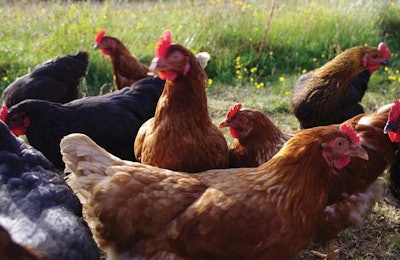
There is no universal standard for the outdoor stocking density of free-range laying hens, and different certification bodies have their own requirements.
These requirements are not always based on strong evidence, meaning that not all current stocking density recommendations applied around the world will necessarily result in the best returns for egg producers nor the best welfare for hens.
Ongoing studies in Australia, however, which have recorded several indicators of how laying hens are affected by different stocking densities, may help to solve this problem.
The work, carried out as part of the Poultry CRC’s research project, "Outdoor stocking density in free-range laying hens: Effects on welfare," has, however, been conducted only on experimental farms and is yet to be applied to commercial premises.
Behavioral change
Bird behavior was measured in stocking densities of 2,000, 10,000 and 20,000 hens per hectare (hens/ha) to determine whether certain behaviors used as welfare indicators were influenced by the number of birds on the range.
Observations of hens indoors and outdoors showed that when hens were provided the choice, they preferred to dust bathe and forage outdoors, but rest indoors, and the frequencies with which they exhibited these behaviors were affected by stocking densities to varying degrees.
Hens from the lowest stocking densities used the range the most, while those in the highest-density flocks used it the least.
With more hens going outside, hens in the lowest stocking density had more space indoors, and this enabled them to rest more easily as they were less likely to be disturbed by other birds.
A clear relationship between resting outdoors and stocking density was also observed.
Birds in the lowest stocking density rested outdoors the most, while those in the highest density rested the least.
At the end of the study, birds across the three stocking densities were found to be in good physical condition, suggesting that there are no implicit health issues arising from stocking birds up to 20,000 per hectare, despite changes in behavior.
Stress hormone
Levels of corticosterone in eggs from flocks with three densities was also recorded. Corticosterone concentrations can be used as a measure of stress over time.
Among findings was that, at 35 weeks of age, birds stocked at 10,000 hens/ha produced eggs with the smallest change in corticosterone concentrations.
Albumin corticosterone levels at 35 weeks in eggs from birds stocked at 20,000 hens/ha suggested they were more stressed than birds kept at lower stocking densities. However, the researchers note that further work needs to be conducted to interpret albumen corticosterone levels in relation to short- and long-term stressors and overall adaptability of birds.
While the results show that outdoor stocking density affects how much hens will use the range and the frequency of specific behaviors that are important for welfare, the researchers recognize that management plays a strong role in maintaining hens in good condition.
Australia study aims to optimize free-range laying hen welfare
www.WATTAgNET.com/articles/20273

















